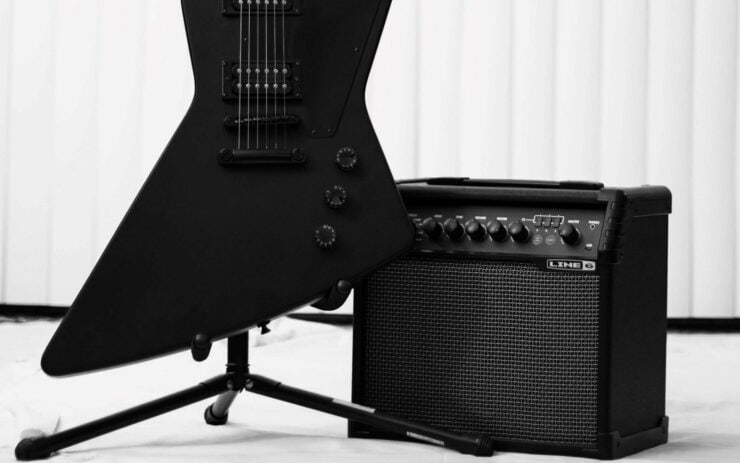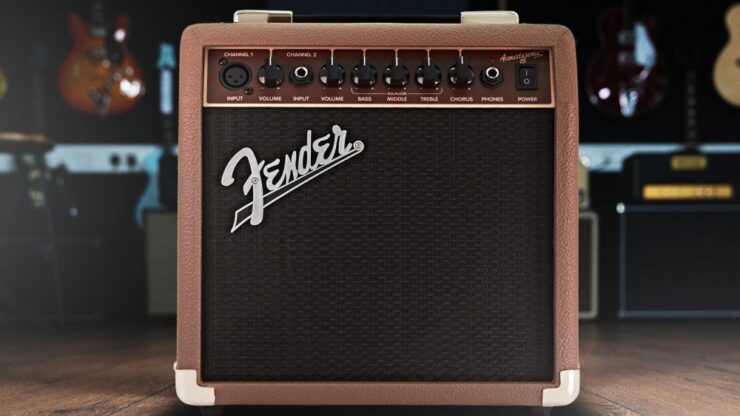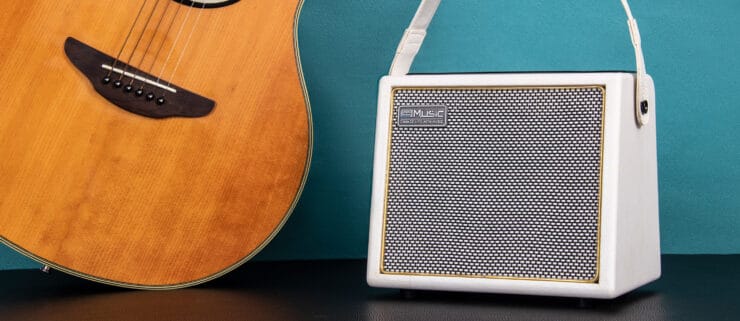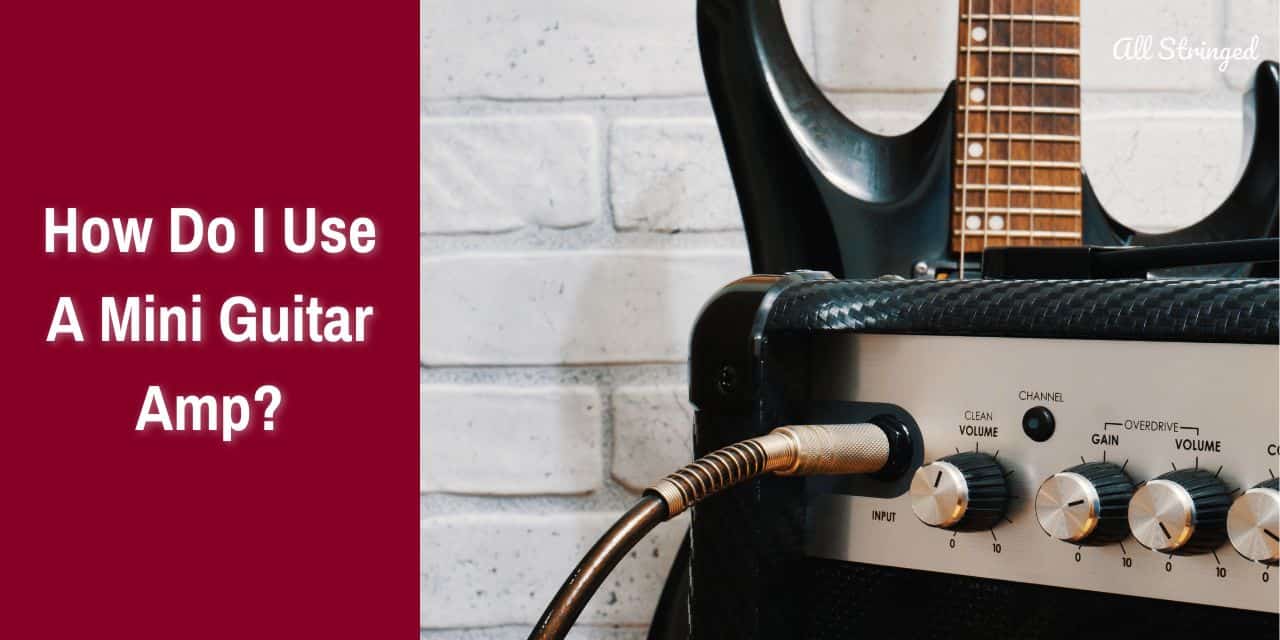Are you a guitarist looking to take your sound to the next level? Mini guitar amps are a great way to get the most out of your sound with a small, compact package. In this article, we’ll be discussing how to use a mini guitar amp to maximize your sound and take your guitar playing to the next level. From setting up your amp to tips on how to get the most out of your sound, we’ve got you covered. Keep reading to learn more and take your guitar playing up a notch!
Where are mini guitar amps used?
Mini guitar amps have been becoming an increasingly popular choice among guitarists due to their compact size, portability, and convenience. These pint-sized amps offer a wide range of features and benefits that make them a versatile tool for musicians of all levels.
A mini guitar amp or also known as a portable or practice amp is a compact amp designed specifically for electric guitars. Unlike their larger counterparts, mini guitar amps are smaller in size and often run on batteries or have a built-in rechargeable power source. They are typically lightweight and quite easy to carry, which makes them perfect for practice sessions, small gigs, travel, and on-the-go performances.
>>> Click here to read our review about the Top 15 Best Mini Guitar Amps <<<
Mini guitar amps are well-suited for practice sessions at home. Their compact size allows for easy setup in small spaces, such as dorm rooms, bedrooms, or apartments, where larger amps might not be a practical option. They offer a rather convenient solution for guitarists who wish to practice without disturbing others, thanks to the compatibility with headphone jacks for private listening. Some models also come with auxiliary inputs, allowing you to play alongside backing tracks or songs from external devices.
Mini guitar amps are excellent for small gigs, busking sessions, or street performances. They are lightweight and quite easy to transport, which allows you to take your music wherever you go. Whether you are playing in a park, coffee shop, or on the street, a mini guitar amp will provide the needed amplification without the need for bulky and heavy equipment. Their compact size and portability make them an ideal option for musicians and guitarists on the go.
When traveling, whether for gigs or leisure, mini guitar amps are a practical option for guitarists who want to continue practicing or performing. They fit easily into travel bags or guitar cases, which makes them convenient companions for musicians on the road. Moreover, mini guitar amps are suitable for impromptu jam sessions with friends or other musicians, allowing you to plug in and play wherever inspiration strikes.
Mini guitar amps can be a valuable tool for recording and studio work. Their compact size and direct connectivity options make them quite easy to incorporate into a recording setup. Mini guitar amps can provide a consistent and reliable tone, making them a rather convenient solution for home studio recording or when space is limited in professional studios. They can be connected directly to audio interfaces or mixers, allowing you to capture your guitar tracks with ease.

Benefits of using a mini guitar amp
Musicians and guitarists are always looking for ways to enhance their playing experience and explore new grounds. This is where the mini guitar amp comes into the picture. It is a compact and portable solution that offers a wide range of benefits for musicians of all levels. Here are some of the benefits of using a mini guitar amp and how it can amplify your playing anytime, anywhere.
#1. The prospect of practice sessions anywhere
Mini guitar amps are an excellent choice for practice sessions. Their compact size makes them perfect for use in small living spaces, such as apartments or dorm rooms, where larger amps might not be suitable. You can easily set up your mini amp on a desk, table, or even the floor without taking up much space.
Moreover, many guitar amps also feature headphone jacks, allowing you silent practice. This is especially useful when you wish to practice late at night or don’t want to disturb others around you. You can plug in your headphones and enjoy a private playing experience while still benefitting from the amp’s tone and responsiveness.
#2. A high level of portability
One of the standout benefits of a mini guitar amp is its portability. This type of amp is designed to be lightweight and compact, which makes them easy to carry and transport. Whether you are a traveling musician, a busker, or simply someone who wishes to practice on the go, a mini guitar amp allows you to take your music with you wherever you venture. Its small size means it can fit into a backpack, or travel case, or even be hand-carried, ensuring that you can amplify your playing no matter where your musical journey takes you.
#3. A surprising amount of versatility
Despite their small size, mini guitar amps offer a surprising amount of versatility. They often come equipped with different tone-shaping controls, including gain, tone, and volume knobs. Some models also feature built-in effects, such as reverb, delay, or modulation, allowing you to experiment and create different tones and textures.
This versatility makes mini guitar amps suitable for different musical genres and playing styles. Whether you are into blues, jazz, rock, or metal, a mini guitar amp can provide the tones that you need to bring your music to life.
#4. Portraying your unique sound
Mini guitar amps offer a unique opportunity to showcase your individual playing style and sound. Their compact nature means that you can position them close to your ears, allowing you to fully immerse yourself into the tone and intricacies of your playing.
The intimate connection between you and your mini guitar amp allows for a more personal playing experience, where you can better hear and feel the nuances of your guitar. This closeness can result in a deeper connection with your instrument and more expressive performance.

#5. Deliver performances that are more intimate
Mini guitar amps are perfect for small and intimate performances. Whether you are playing at a small gathering, a coffee shop, or in a street performance, a mini amp will provide sufficient amplification without overpowering the space.
They can deliver enough volume to be heard by your audience while still maintaining a balanced sound that suits the setting. Moreover, their compact size makes them easy to set up and tear down, saving you time and effort when moving between performance venues.
How do I use a mini guitar amp?
Setting up and using a mini guitar amp doesn’t need to be a complex process. Whether you are a beginner guitarist or a seasoned player, understanding how do I use a mini guitar amp will be important. It will help you ensure optimal sound quality and a more enjoyable playing experience. Here are the steps you’ll need to follow for setting up and using a mini guitar amp.
Step 1: Connect the amp to your guitar
First, you should gather your equipment, making sure that you have your mini guitar amp and a suitable instrument cable. Then, you need to locate the input jack on your mini guitar amp. It will typically be located on the front panel or the top of the amp.
After that, plug in the instrument cable. Take one end of the instrument cable and then insert it into the input jack of the mini guitar amp. Make sure that it is firmly connected. Connect the other end to your guitar. Take the other end of the instrument cable and then plug it into the output jack of your guitar. Make sure that it is securely connected.
Step 2: Connect the amp to a speaker
Now, you need to determine your speaker options. Mini guitar amps typically come with built-in speakers, but some models might also offer additional options for connecting external speakers. Check the specifications of your mini guitar amp to see if it supports external speaker connections.
Then, identify the speaker output. If your mini guitar amp supports external speakers, locate the speaker output jack on your guitar amp. It might be labeled as “External Speaker” or “Speaker Out”. Take one end of the speaker cable and then plug it into the speaker output jack on your mini guitar amp. Make sure that there is a secure connection.
After that, connect the other end to the speaker. Plug the other end of the speaker cable into the input jack on your speaker cabinet. Make sure that it is firmly connected. Power on your mini guitar amp and play your guitar to make sure that sound is coming through the speaker cabinet. Adjust the volume as needed.
Step 3: Adjust the settings
Set the volume level. Start off with the volume level on your mini guitar amp set to a low or moderate level. This will allow you to adjust the volume gradually as needed without overwhelming the sound.
Most mini guitar amps come with tone controls such as bass, treble, and mid. Experiment with these controls to find your desired sound. Start off with the controls set to the middle position and then make adjustments based on your preferences.
Some mini guitar amps come with additional features and settings such as reverb, gain, or built-in effects. Take the time to explore these options and adjust them to your liking. Experiment with different settings to find the ones that suit your playing style and musical genre.
Play your guitar and listen carefully to the sound coming from the mini guitar amp. Make any necessary adjustments to the volume, tone, and other settings until you achieve the desired sound quality.
Tips on how do I use a mini guitar amp
Mini guitar amps have truly revolutionized the way musicians and guitarists practice, perform, and explore their musical creativity. Mini guitar amps are compact and portable amps that offer a world of possibilities for guitarists, combining portability with impressive sound. To make the most of your mini guitar amp, it is important to know tips and tricks on how do I use a mini guitar amp. Here are some of the tips that you should keep in mind when using a mini guitar amp to maximize your amp experience.
#1. Adjust the tone
Fine-tuning the tone on your mini guitar amp can significantly enhance your playing experience. To help achieve your desired sound, you’ll need to experiment with the EQ, adjust gain and volume control, use your guitar’s tone controls, and experiment with positioning.
Most mini guitar amps feature bass, treble, and mid controls. Adjusting these EQ controls will allow you to shape your tone to match different musical styles. For instance, boosting the bass can provide a thicker and heavier tone, while increasing the treble can add brightness and clarity. Play around with these controls for finding the balance that suits your preferences.
The gain control on your mini guitar amp will determine the amount of distortion or overdrive. Adjusting this control can help you achieve a cleaner tone or add crunch and sustain. Pair it with the volume control to balance the overall output level.
Don’t forget to utilize the tone controls on your guitar itself. Adjusting the tone knobs will further shape your sound, allowing you to cut through the mix or add warmth depending on your needs.
Even with a mini guitar amp, changing the mini guitar amp’s position can affect the sound. Moving it closer to a wall or placing it on different surfaces can result in subtle tonal variations. Experiment with the amp placement to find the sweet spot that complements your playing style.
#2. Utilize the effects pedals
Effects pedals are a great way of expanding your sonic palette when using a mini guitar amp. For incorporating effects pedals into your setup, you need to start off with the basics. Begin by experimenting with essential effects pedals such as delay, distortion, reverb, and modulation. These pedals can add texture, depth, and ambiance to your sound.
The order in which you connect your effects pedals can significantly impact the overall sound. As a general rule of thumb, you should place your time-based effects (reverb, delay), at the end of the signal chain, after modulation and distortion effects. This placement will ensure that the time-based effects capture the final, processed signal.
If your mini guitar amp has an effects loop, consider connecting modulation and time-based effects directly into the loop. This setup will allow you to achieve a more integrated and natural sound, as the effects are applied to the amplified signal rather than the preamp signal.
You can also try to experiment with stacking. Stacking effects pedals can create unique and complex sounds. Try to combine different pedals to explore new sonic territories. For instance, layering a distortion pedal with a modulation pedal will result in intriguing textures and tonal possibilities.
#3. Explore headphone options
One of the greatest advantages of mini guitar amps is their compatibility with headphones, allowing for silent practice and private listening. To make the most of playing your mini guitar amp with a headphone, you need to use headphones with a suitable impedance, enjoy virtual amp simulations, and experiment with virtual effects.
Make sure that your headphones match the impedance range recommended by your mini guitar amp. Using headphones with the correct impedance can help preserve the integrity of the sound and ensure optimal performance.
Some mini guitar amps also offer built-in amp modeling, allowing you to simulate the sound of various iconic amps. When using headphones, you should take advantage of these features for accessing a vast library of amp tones without disturbing others.
In addition to amp modeling, mini guitar amps often include virtual effects such as delay, reverb, and modulation. Use headphones for exploring these effects and experiment with different settings. This headphone-exclusive experiment can result in creative discoveries with new musical ideas.

#4. Experiment with mic placement
If you have the option to mic your mini guitar amp, you should experiment with different mic placements to capture the desired tone. Move the mic closer or further away from the speaker, adjust the angle, and experiment with different types of microphones (condenser or dynamic) for achieving the sound that you are looking for. Mic placement can greatly influence the recorded or amplified sound, allowing you to customize your tone further.
#5. Embrace the versatility
Mini guitar amps are incredibly versatile and they can be used in different settings and situations. Whether you are practicing at home, performing on a small stage, recording in a studio, or jamming with friends, your mini guitar amp can be your trusty companion.
You should embrace the convenience, portability, and flexibility that mini guitar amps offer and adapt them to your needs. Experiment with different environments, genres, and musical contexts to explore the full potential of your mini guitar amp.
Different types of mini guitar amps
Mini guitar amps have become the talk of the guitar world thanks to the portability and amazing performance they deliver despite their compact size. Within the realm of mini guitar amps, there are different types of mini guitar amps available, each with its unique characteristics and advantages. Here are the different types of mini guitar amps that you can go for. By understanding the differences between these types, you’ll be able to make a well-informed decision when choosing the best type of mini guitar amp to suit your needs.
Battery-powered amps
Battery-powered amps are designed to run on batteries, which makes them incredibly portable and ideal for on-the-go playing. These mini guitar amps typically use standard batteries or rechargeable batteries, allowing you to take your music anywhere without the need for a power outlet.
These amps are convenient for busking, outdoor performances, or situations where electrical power is limited. They often offer a compact form factor, with some models even fitting in your pocket. While battery-powered amps might have limitations in terms of power and volume compared to larger amps, they provide a practical solution for portable amplification.
Digital modeling amps
Digital modeling amps make use of Digital Signal Processing technology for replicating the sound characteristics of various amps and effects. These amps often have a wide range of built-in amp models, allowing you to emulate the tones of iconic amplifiers from different eras and genres.
These amps use digital signal processing for recreating the sonic characteristics of tube amps, solid-state amps, and more. This versatility will allow you to experiment with different amp models and effects without the need for physical equipment. Moreover, digital modeling amps often provide extensive control over parameters such as gain, EQ, and effects, giving you a wide palette of tonal options. They are particularly popular for home recording, practice sessions, and performances where versatility will be important.
Hybrid amps
Hybrid amps combine the characteristic of both tube amps and solid-state amps, offering a unique blend of tonal qualities. These mini guitar amps typically feature a tube preamp section and a solid-state power amp section.
The tube preamp provides warmth, dynamics, and harmonic richness while the solid-state power amp delivers efficiency and reliability. These amps often aim to provide the tonal characteristics and responsiveness of tube amps at a lower cost and in a more compact package. They offer a balance between vintage warmth and modern convenience, making them suitable for various musical genres and playing styles.
FAQs
What are the benefits of using a mini guitar amp?
Mini guitar amps are compact and lightweight, making them perfect for practice on the go. They also typically have lower wattage, allowing for a quieter sound that won’t disturb others in the same room. Mini guitar amps are also ideal for beginners who want to practice without having to invest in a full-sized amp.
What should I consider when buying a mini guitar amp?
When buying a mini guitar amp, it’s important to consider the wattage, speaker size, tone control, portability, and budget. Some mini amps may also come with extra features such as headphone jacks and aux inputs. It’s important to find the right balance of these features to ensure you get an amp that meets your needs and provides a great playing experience.
How do I use a mini guitar amp?
Using a mini guitar amp is fairly straightforward. Once you’ve plugged in your guitar and turned on the amp, you can adjust the tone and volume controls to your desired settings. You can then start playing and experiment with different tones. Some mini amps may also come with additional features such as headphone jacks, aux inputs, and built-in effects, so be sure to familiarize yourself with all the features



